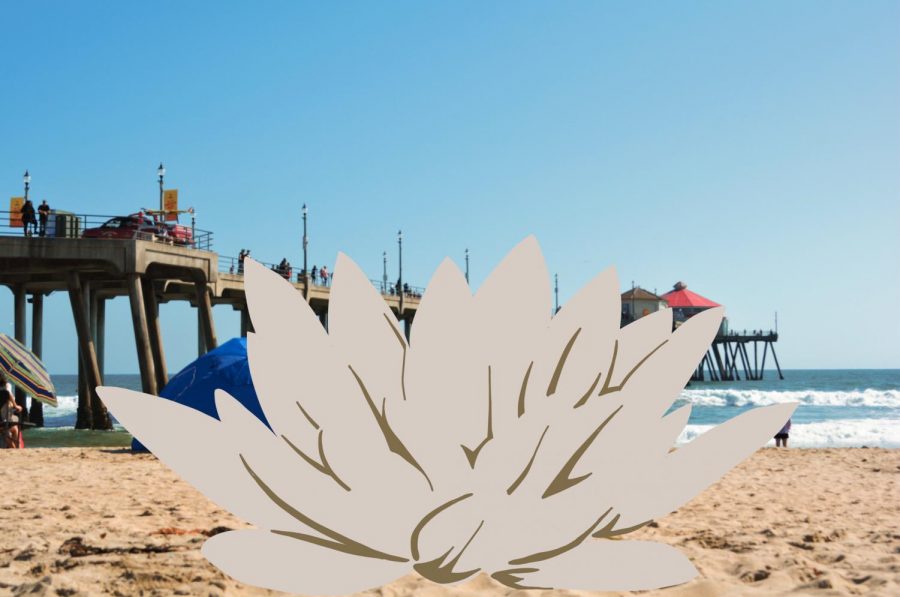Review: The white existentialism of ‘The White Lotus’
HBO’s splashy summer drama probes at America’s colonial past, but doesn’t manage to rewrite a critical future.
HBO’s The White Lotus was the streaming darling of the summer. The show attempts to probe America’s colonial past in this satire of the tourism industry. (Staff Photo and Illustration by Manasa Gudavalli)
August 30, 2021
Cradled by lapping tides, a boat full of white, wealthy and unreasonably attractive patrons arrive at the paradisiacal island of Maui as doting staff members wave from the distance, relegated to a mere speck within the frame. This is one of the first scenes of creator Mike White’s latest show “The White Lotus” — a moment that remains emblematic of the entire series throughout its six-episode run.
The show’s opening concerns a mysterious corpse being packed into an outgoing flight and a man returning from his (presumably ruined) honeymoon. This image hangs over the audience as the series then loops back to the beginning, showing the events leading up to this untimely death. With this, we officially meet the primary cast of characters. First, a WASP-y tech family and their daughter’s friend Paula, then a lonely woman named Tanya mourning her dead mother (played with hilarious brevity by one Jennifer Coolidge), and, finally, the newlywed couple — who have already grown to disdain each other — going on their honeymoon.
These three groups each have equally fraught dynamics that bleed into one another and come to separate dramatic climaxes as the series continues. But what really gives the show depth is the eclectic staff that runs the hotel on the sidelines, including a bellhop named Kai, who begins a secret tryst with Paula that eventually goes south, and the powerhouse hotel manager named Armond, whose eerie ability to snap from drugged-out mania to a hospitable Cheshire cat should receive several accolades. Also on staff is the show’s center of rotation: a Black spa worker named Belinda, whose immaculate service causes Tanya to turn obsessive and demand that Belinda remain at her beck and call. It’s on these characters that the families wreak their havoc, as they belittle, disregard and even flat-out insult the staff in a vain attempt to exert control over their situations.
Watching privileged people spiral under the stylish and seductive atmosphere of a tropical hotel makes “The White Lotus” a late-summer catnip and daring satire of the American tourism industry that has taken over Hawaii — one of the more famous yet ignored examples of stolen and colonized land. However, as well-intentioned as this parodic rendering of the 1% is, the show’s constant focus on the hotel guests creates yet another piece of media obsessed with whiteness.
Instead of opting for parts of the narrative to narrow in on the staff, who are predominantly people of color, White chooses to only skewer the problematic behavior of the new arrivals. We see the twists and turns of snobby newlywed Shane’s erratic behavior towards Armond as retaliation for Armond’s failure to give him the suite he wanted. We watch in horror as tech company girlboss Nicole espouses neoliberal Twitter lingo about cancel culture to her teenage children. Even more heartbreakingly, we see Tanya’s obsession with Belinda’s service culminate in her revoking an offer she made to fund Belinda’s wellness company, leaving Belinda in tears at the front desk.
All of this is as wild as it is painfully accurate. Unfortunately, the hotel industry is curated to satisfy every demand of entitled white people. The working-class people of color employed at these establishments are seen as completely replaceable, perhaps best represented by the pilot episode in which a trainee gives birth in the hotel lobby — only to never appear in the series again. There’s a cruel cyclical nature to the hospitality industry that “The White Lotus” completely nails, as the white guests take over or even colonize the frame. However, it can be argued that the series leans too far into a realm of existential pessimism for its point to resonate.
Though the series is spot on in its representation of overwhelming whiteness in the tourism industry, the plotlines are not nuanced enough to warrant embodying its own critique. The same points about class, colonialism and race can be made while giving secondary characters an equal amount of screen time. Why can’t the audience know exactly why Kai told Paula that he was forced to take this job? How does Belinda recover everyday from catering to white people? In short, why are these characters not portrayed as interesting enough to legitimately be represented — even when the narrative is about them?
A didactic history lesson about America’s colonial past isn’t even required here. Indigenous TikTok creators have already gone viral doing the free labor of explaining how Hawaiian tourism has gotten so out of hand. Even just an outline of these hotel worker’s lives would have painted a richer portrait of the gruesome effects of the hospitality industry, rather than merely showing the fiery entitlement we’ve already come across in HBO’s other popular outfits such as “Succession” or “Big Little Lies. “
Beyond the way unlikeability is constantly performed and presented here, the way some of the characters are written leans more toward caricature than complexity. Though played with gusto, Shane’s whiny condescension as he calls his new wife a trophy makes for more of an operatic villain than a legitimate breakdown of the male ego. “The White Lotus” could’ve created human or even slightly relatable characters that evoke the quotidian microaggressions that most people in the service industry have to face on a daily basis. Instead, the series seems determined to address all problems with tourism in Hawaii with a few crazed examples rather than as a nuanced problem with many moving parts.
The finale of the miniseries sees the three parties swiftly making their exit as the murderous plotline comes to a harrowing conclusion. The families remain relatively unscathed, but the staff members go back to exactly where they started: smiles plastered on and waving to the horizon. This ending relays the hopelessness that “The White Lotus” was determined to convey and presents the characters’ separate fates as inevitable. This sequence mourns for yet accepts tourism’s effects in Hawaii and makes the twisty plotlines feel more like an admission of obvious guilt rather than a revelatory exploration of underserved populations.
“The White Lotus” is a series that is undeniably successful by way of entertainment. From its swelling score to the mesmerizing set design, the series begs the viewer to stay glued to the screen for whatever narrative sucker punch may approach the idyllic location. It was this aspect that most likely caused HBO to renew the series for a second season and possibly more in the future. However, as “The White Lotus” continues, it’s in the audience’s best interest to consider how much more self-indulgent critique from white creators is needed and if they should just move aside.
A version of this article appears in the Monday, August 30, 2021, e-print edition. Email Isabella Armus at [email protected].




























































































































































